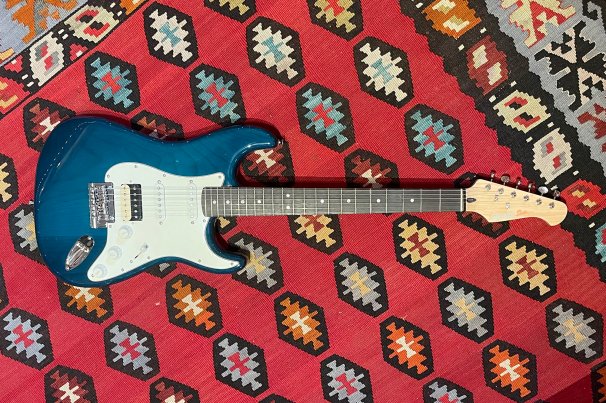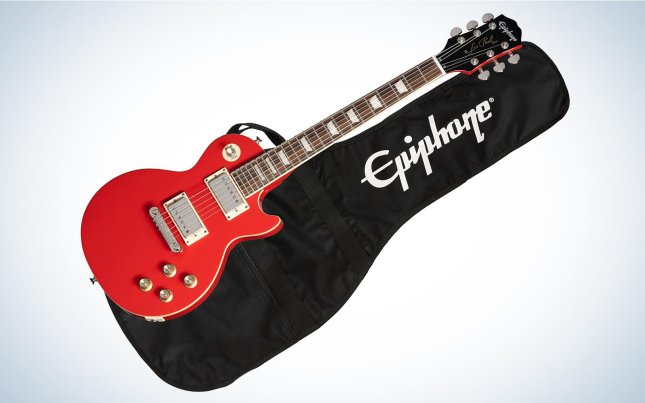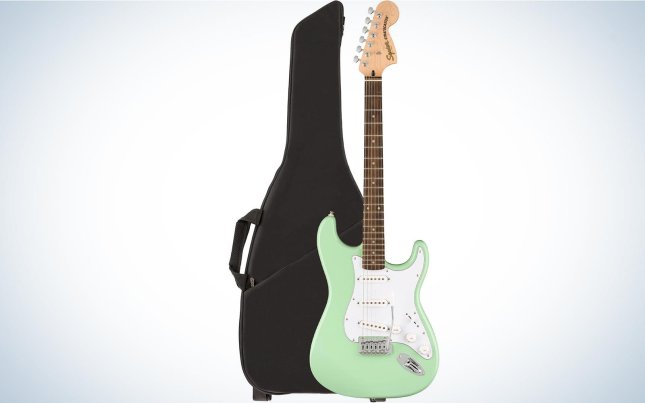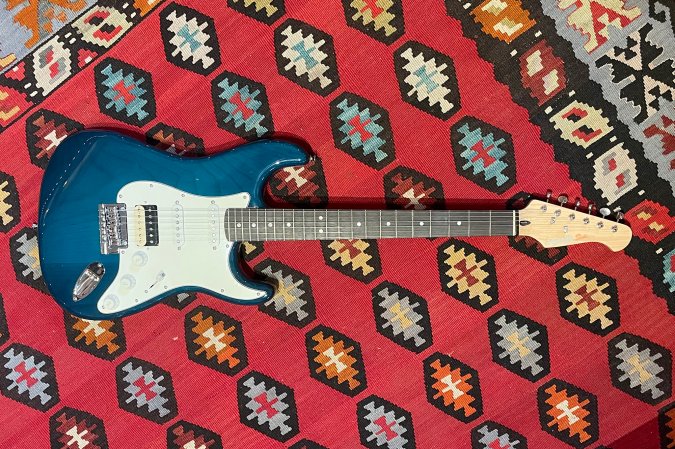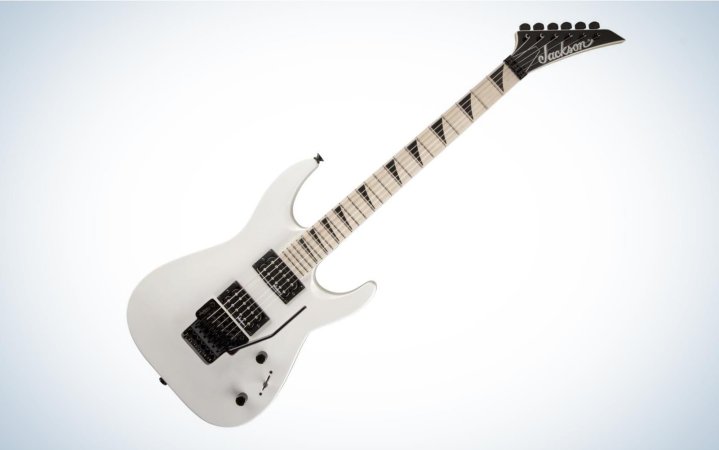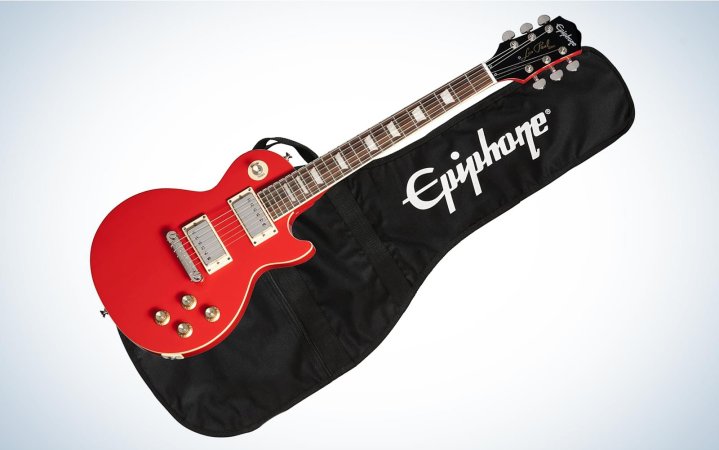We may earn revenue from the products available on this page and participate in affiliate programs. Learn more ›
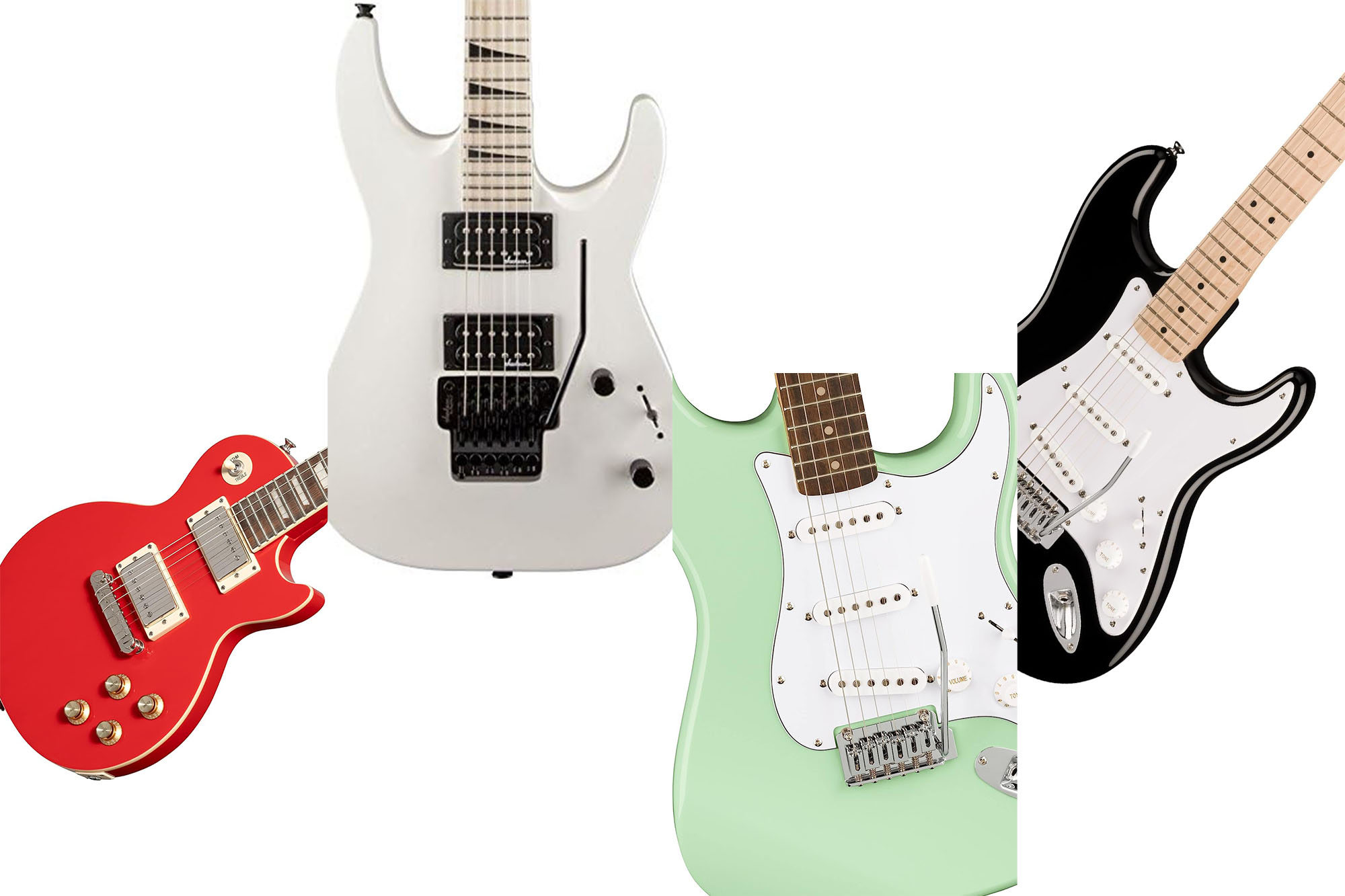
Learning an instrument can be expensive, but a cheap electric guitar can provide a great place to start. In this case, “cheap” doesn’t mean “bad.” Many well-known guitar brands have specific budget- and beginner-friendly lines for players just starting out. These lines often share major characteristics and similar hardware of professional guitars in higher price brackets. A cheap electric guitar also means you won’t dump too much money into your new (and potentially fleeting) hobby if you decide that you’re not ready for the rockstar lifestyle. Shred some power chords—not the cash in your wallet—with the best electric guitars.
- Best overall: Donner 39-inch Electric Guitar
- Best for beginners: Fender Squire Sonic Stratocaster Electric Guitar
- Best for metal: Jackson JS32 Dinky DKA-M Electric Guitar
- Best kit: Fender Squier Affinity Stratocaster Limited Edition Bundle
- Best value: Epiphone Power Player Les Paul
How we chose the best cheap electric guitars
We don’t mean to brag, but many of the PopSci Gear team know a thing or two about guitars. Although we’ve been in plenty of bands, we’ve also been beginners ourselves. We combined our personal experience with recommendations from professional music pals. We also heavily researched reviews from trusted sources to narrow our picks. To make sure each guitar was truly cheap, we capped prices at $300. Only one guitar on this list exceeds that range, but we had very good reason to make an exception, which we’ll explain.
The best cheap electric guitars: Reviews & Recommendations
From short-lived high school bands formed in garages to far-away travel gigs where you don’t want to bring your prized, expensive guitar on a budget airline, a cheap guitar can be a valuable addition to your guitar stand or rack. One of our choices should help you live out your rockstar dreams.
Best overall: Donner 39-inch Electric Guitar
Donner 39-inch Electric Guitar
Pros
- Includes accessories
- Classic style
- Versatile single-coil and humbucker pickups
Cons
- Need proper set-up for long-term playability
Specs
- Body: Solid alder, gloss polyester finish
- Scale length: 25.5 inches
- Fretboard: Laurel, 9.5-inch radius, 22 medium-jumbo frets
- Accessories: Gig bag, guitar strap, guitar cable
The Donner DST-400 is the ideal vision for what we want in a cheap electric guitar. It’s budget-friendly, but its solid body and reliable production quality control allow it to last well past your early stages. It includes both single-coil and humbucker pickups to play a wide range of styles, and its classic design means it will never go out of style. It feels great to play and is ready to go right out of the box.
It also includes basic accessories to get you started: A gig bag, a guitar strap, and a guitar cable. You’ll need to upgrade your amp after the beginner stages, but there’s no better deal than this Donner.
Best for beginners: Fender Squire Sonic Stratocaster Electric Guitar
Fender Squire Sonic Stratocaster Electric Guitar
Pros
- Well-built for price
- Feels good in hands
- Recognizable body
Cons
- Doesn’t come with accessories
Specs
- Body: Poplar
- Scale length: 25.5 inches
- Fretboard: Maple, 9.5-inch radius, 21 narrow tall frets
- Accessories: No
The Stratocaster is one of the music scene’s most iconic and recognizable guitars. You’re in good company if you pick one up, too. Greats like Buddy Holly, George Harrison, and Jimi Hendrix have called the Stratocaster their choice guitar. Beginners can get in on the fun without shelling out too much cash with Fender’s Squire line, which gives you a reliable instrument made with low cost in mind. Its thin, lightweight body and matte neck feel good in your hands, and it has a similar feel and tone to more expensive Strats. Experienced players will hear the difference in pickups: This one comes with ceramic single-coil pickups, while a traditional Strat comes with alnico (short for aluminum, nickel, and cobalt) pickups. But to a newcomer, it’s a solid guitar that punches above its price point.
Best for metal: Jackson JS32 Dinky DKA-M Electric Guitar
Jackson JS32 Dinky DKA-M Electric Guitar
Pros
- Big tone for low price
- Ready to play out of the box
- Quality construction
Cons
- A bit more expensive than our other choices
Specs
- Body: Solid basswood
- Scale length: 25.5 inches
- Fretboard: Maple, 12” compound radius, 24 jumbo frets
- Accessories: No
If you’re looking for a guitar that doesn’t cost much but shreds a lot, this is the one for you. The neck is comfortable even when playing fast, speedy passages and its lightweight body doesn’t drag you down over the course of a set. Its solid construction holds up well for years and years, and it’s another choice that plays above its price. It’s playable out of the box and sounds punchy and vicious. It’s more expensive than our other picks, but only by $100. We think its design made for shredding is worth that extra dough.
Best kit: Fender Squier Affinity Stratocaster Limited Edition Bundle
Fender Squier Affinity Stratocaster Limited Edition Bundle
Pros
- Comes with an instructional DVD
- Lots of bonus accessories
- Incredible price for what you get
Cons
- Reviews note some items from bundle are missing from order
Specs
- Body: Poplar
- Scale length: 25.5 inches
- Fretboard: Maple, 9.5-inch radius, 21 medium-jumbo frets
- Accessories: 10G amplifier, gig bag, instrument cable, tuner, strap, picks, and instructional DVD
This kit is a one-stop solution if you want to buy a guitar but don’t know where to start. The Fender Squire Affinity Stratocaster is the next price step up from the Sonic series, and the medium jumbo frets make for smooth playing. The amp is perfect for practicing at home, and the included instructional DVD means you don’t have to shell out cash for lessons. Some reviews note that their order arrived incomplete; the same reviews also noted that the seller is responsive and happily sends any missing items.
Best value: Epiphone Power Player Les Paul
Epiphone Power Player Les Paul
Pros
- Small scale
- Iconic guitar
- Stays in tune longer
Cons
- Not great for someone looking for longevity
Specs
- Body: Mahogany
- Scale length: 22.73 inches
- Fretboard: Laurel, 12-inch radius, 22 frets
- Accessories: Gig bag, strap, picks, guitar cable
The Les Paul is an iconic guitar named and created by Les Paul, a prolific jazz, country, and blues guitar player. The Les Paul guitar is one of the most versatile guitars. It can tackle rock, blues, and jazz and is perfect if you’re looking for a full and resonant sound. This one comes from Gibson’s Epiphone line, which is similar to Fender’s Squire line. It’s a great size for youths and makes for a great travel guitar for more experienced players. It has a comfortable neck and stays in tune longer compared to other student models. Plus, humbucker pickups make even the easiest of chords sound rich, warm, and heavenly. This is a guitar made with students in mind, so it might need to be replaced as the player grows.
What to consider when buying the best cheap electric guitars
Not all axes are made the same. Here’s what to look for when shopping for the best cheap electric guitars.
Scale length
Scale length is the distance between the nut of the guitar and the bridge. Shorter scales can be good for younger players who don’t have large enough hands for bigger instruments. A normal scale for a guitar is around 25 inches. However, guitars with a shorter scale have less string tension, which is a recipe for fret buzzing (when the note sounds “fuzzy” because you’re not pressing hard enough on the string) and intonation problems.
The fret distance on a 25.5-inch scale guitar only differs about a thousandth of an inch from that of a 24.75-inch scale guitar. That may not sound like much, but the difference is noticeable for players. At the end of the day, it matters that the guitar feels right in your hands, and choosing the right scale helps with that.
Pickups
Without pickups, your electric guitar would just be a quiet, terrible-sounding acoustic. These magnetic components sit under the strings and convert the vibrations from the strings into electrical current and eventually sound.
Single-coil and humbuckers (double coil) are the most well-known designs of pickups:
- Single coil: Brighter, crisper, work better with clean sounds, more note definition between strings.
- Humbuckers: Warmer, darker, work better with distorted sounds, less note definition between strings.
Pickups generate two kinds of voltage:
- Passive: Generates voltage with magnets only. Guitars with passive pickups are generally cheaper and create more expression because they’re sensitive to the vibration of the strings.
- Active: Generates voltage with weaker magnets that are supported by a preamp. Greater tonal clarity. They create more tonal consistency at different volumes.
Versatility
Different guitars generate different timbres (the quality of the note), which suit specific genres. You can always change the sound with the pedals on your pedalboard, but some tones come inherent to the guitar. A Fender Stratocaster is great for rock, pop, blues, jazz, punk, and heavy metal. A Gibson Les Paul is excellent for rock, country, pop, soul, and rhythm and blues.
Fretboard radius
The lower a fretboard’s radius, the more curve it has. Predictably, a higher number translates into a flatter fretboard. Why does that matter? It all goes back to how the guitar feels in your hands. Choosing a fretboard radius is based on preference. Some musicians think curved fretboards are better for chords, while others feel flatter fretboards help them with bar chords.
Player experience
You don’t need to look too deep into things like pickups if you’re a beginner. However, you can save more bang for your buck if you look for a guitar that’s great for beginners and can grow with you as you improve as a musician. The Donner 39-inch Electric Guitar is an example of a beginner-friendly guitar that’s cheap and won’t need to be replaced after a year or two of learning.
FAQs
It depends. If you’re using different tunings for different songs, having a specific guitar for that tuning can make it easier to switch from one tuning to another. Guitars also have certain tones, from the crisp, cleanness of a Fender Stratocaster to the absolute sonic racket of a Gibson Les Paul.
With good care, even a cheap electric guitar can last between 20-30 years.
By “hurt less,” we assume you’re talking about the raw, throbbing pain on your fingertips when you first begin to play. Electric guitars have a thinner neck, less space between frets (making it easier to reach each note in a chord), and the strings sit closer to the fretboard. This means it requires less pressure and a lighter touch to play a note. However, the only true way you’ll “hurt less” when playing the guitar is practicing, which will build up your calluses and finger strength.
That is an entire article in itself! To make a long answer short, it depends on personal preference and what you’d like your signature sound to be. A pickup alone also doesn’t determine your sound: neck and body tonewoods also have an effect. There is no wrong answer when it comes to choosing a guitar pickup
Depending on the build, a cheap electric guitar will run you between $140-$400.
Final thoughts on the best cheap electric guitars
- Best overall: Donner 39-inch Electric Guitar
- Best for beginners: Fender Squire Sonic Stratocaster Electric Guitar
- Best for metal: Jackson JS32 Dinky DKA-M Electric Guitar
- Best kit: Fender Squier Affinity Stratocaster Limited Edition Bundle
- Best value: Epiphone Power Player Les Paul
If you want to learn to play guitar but don’t want to spend a lot of money, consider a cheap electric guitar. They’re perfect for beginners who may not want to invest a ton of cash into a new hobby, or for those who want to learn guitar on a budget. Many guitar makers have specific, beginner-friendly lines that are easy on your wallet—just add a stand and a practice amp and you’re set. Now get to practicing, you rockstar.
